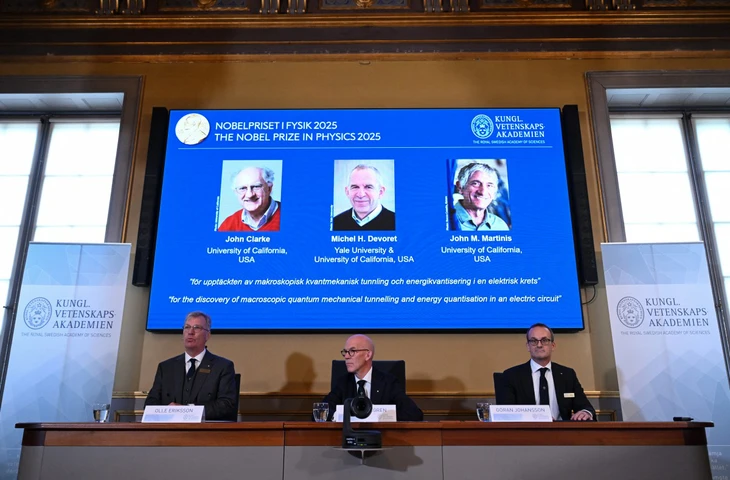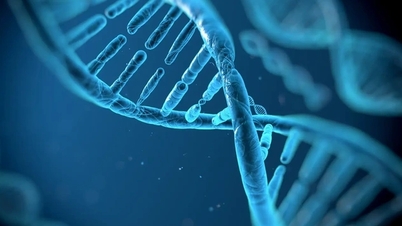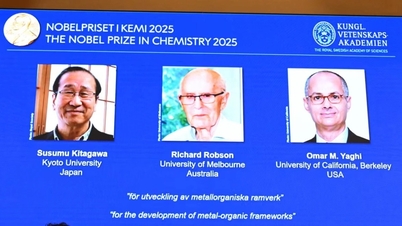
The 2025 Nobel Prize in Physics winners were announced on October 7 - Photo: AFP
On the afternoon of October 7 (Vietnam time), the Royal Swedish Academy of Sciences announced the award of the 2025 Nobel Prize in Physics to scientists John Clarke, Michel H. Devoret and John M. Martinis "for their discovery of macroscopic quantum mechanical tunneling effects and energy quantization in electric circuits".
"It's wonderful to be able to celebrate the way that centuries-old quantum mechanics keeps bringing new surprises. It's also incredibly useful, because quantum mechanics is the basis of all digital technology ," said Olle Eriksson, Chairman of the Nobel Committee for Physics.
This year's Nobel Prize in Physics has provided an opportunity to develop the next generation of quantum technologies, including quantum cryptography, quantum computers and quantum sensors, the awarding committee said.
Quantum mechanics describes phenomena involving a particle in which a particle can pass straight through a barrier, using a process called tunneling. In quantum physics, these phenomena are called microscopic.
This is in contrast to macroscopic phenomena, which involve a large number of particles. For example, a ball, made of a large number of molecules and without quantum mechanical effects, will bounce back when thrown against a wall.
This year's Nobel Prize in Physics recognizes experiments that demonstrate the quantum tunneling effect can be observed on a macroscopic scale, involving many particles.
The 2025 Nobel Prize in Physics winners have performed a series of experiments to demonstrate that the strange properties of the quantum world can be materialized in a system large enough to hold in your hand, according to the awarding committee.
Their superconducting electrical system can transition from one state to another, as if it were passing straight through a wall.
Last year, the Nobel Prize in Physics was awarded to professors John J. Hopfield and Geoffrey E. Hinton, 'for their fundamental discoveries and inventions that enable machine learning with artificial neural networks'.
The Nobel Prizes have been awarded annually since 1901 to honor achievements in physics, chemistry, medicine, literature and peace. It is not uncommon for several scientists working in related fields - rather than just one individual - to be awarded the prize.
The Nobel Prize in Physics is one of five Nobel Prizes awarded in the will of inventor Alfred Nobel (who died in 1896). This prestigious award comes with a gold medal and a prize money of 11 million Swedish kronor (more than $1 million).
According to the Royal Swedish Academy of Sciences, 118 Nobel Prizes in Physics have been awarded since 1901. The youngest person to receive this prestigious award at the age of 25 was Australian scientist William Lawrence Bragg (1915). The oldest person - 96 years old - to be honored with this award was American scientist Arthur Ashkin (2018).
Some of the physics achievements that have made a big difference and been awarded a Nobel Prize include: The first Nobel Prize in Physics in 1901 was awarded to Wilhelm Röntgen for his discovery of X-rays, which are still used today to diagnose broken bones and for many other purposes.
The charge-coupled device invented by scientists Willard Boyle and George Smith, which won the 2009 prize, created a breakthrough for digital camera technology...
Source: https://tuoitre.vn/nobel-physics-2025-trao-cho-nghien-cuu-ve-co-hoc-luong-tu-20251007143408855.htm


![[Photo] Prime Minister Pham Minh Chinh inspects and directs the work of overcoming the consequences of floods after the storm in Thai Nguyen](https://vphoto.vietnam.vn/thumb/1200x675/vietnam/resource/IMAGE/2025/10/08/1759930075451_dsc-9441-jpg.webp)


![[Photo] Prime Minister Pham Minh Chinh attends the World Congress of the International Federation of Freight Forwarders and Transport Associations - FIATA](https://vphoto.vietnam.vn/thumb/1200x675/vietnam/resource/IMAGE/2025/10/08/1759936077106_dsc-0434-jpg.webp)



































































































Comment (0)